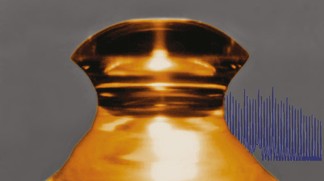Jan 18 2013
EPFL scientists in an international collaboration have demonstrated for the first time the generation of mid-infrared frequency combs in small crystalline micro-resonators. This opens the way to a new class of compact, high precision, sensitive devices for molecular spectroscopy and frequency measurements.

Named after the eponym everyday object, a frequency comb is pulse of light composed of many (from hundreds to several millions) peaks at regularly spaced frequencies, mostly spanning more than an octave, i.e. an interval up to twice the lower frequency.
The high precision with which the frequencies of the peaks (teeth) are known and the high power available are making frequency combs enabling tools for new and unexpected applications. In particular, frequency combs are strongly impacting molecular spectroscopy by dramatically improving the recording speed, the resolution and the accuracy of Fourier spectrometers.
The mid-infrared part the light spectrum is a very interesting one for molecular spectroscopy as it corresponds to the energies of structural vibrations of the molecules. The absorption spectrum in this region therefore gives a unique “fingerprint” and allows the identification of the molecule.
It would be very desirable to be able to measure very precisely frequencies in the mid-infrared, but unfortunately, until now, frequency combs in the mid-infrared were bulky and difficult to set up..
In an article just published in Nature Communications (January 8th, 2013), scientists from Prof. Tobias Kippenberg group (Laboratory of Photonics and Quantum Measurements), in collaboration with universities from Germany and France, have built and actually used in a proof-of-concept case a new class of miniaturized devices that exhibit frequency combs in the mid-infrared.
"The remarkable characteristics of such comb generators are their small size, large line-spacing, high power per comb line, and efficient conversion", says Dr. Christine Wang, the post-doc who has performed the experiment. "An appropriate choice of the material, here magnesium
fluoride, and proper engineering are crucial to realize broad spectral span and low-phase noise, as required for frequency comb operation."
Such miniaturized sources hold much promise for on-chip frequency-comb spectrometers. The spectrum of the fundamental vibrations of liquid phase samples might be measured within a few nanoseconds with a similar refresh time!